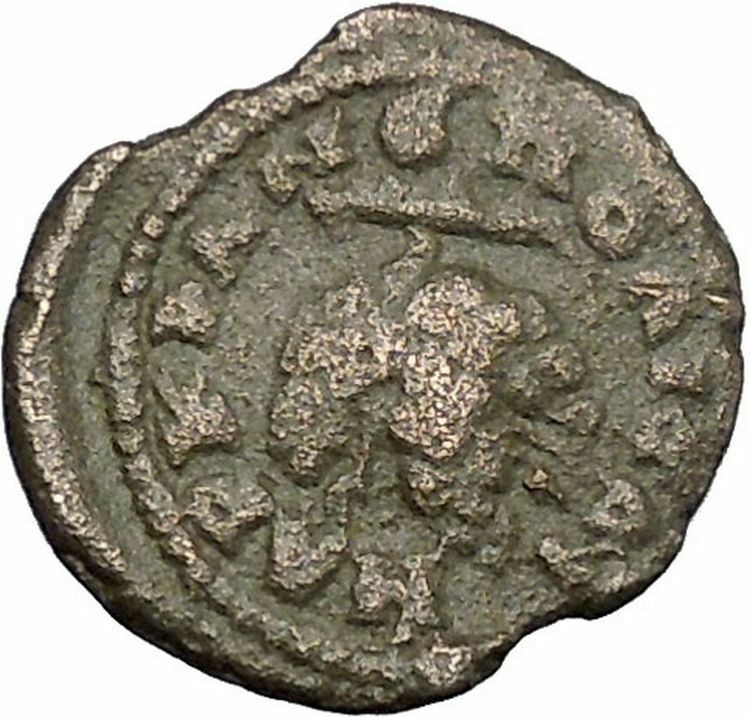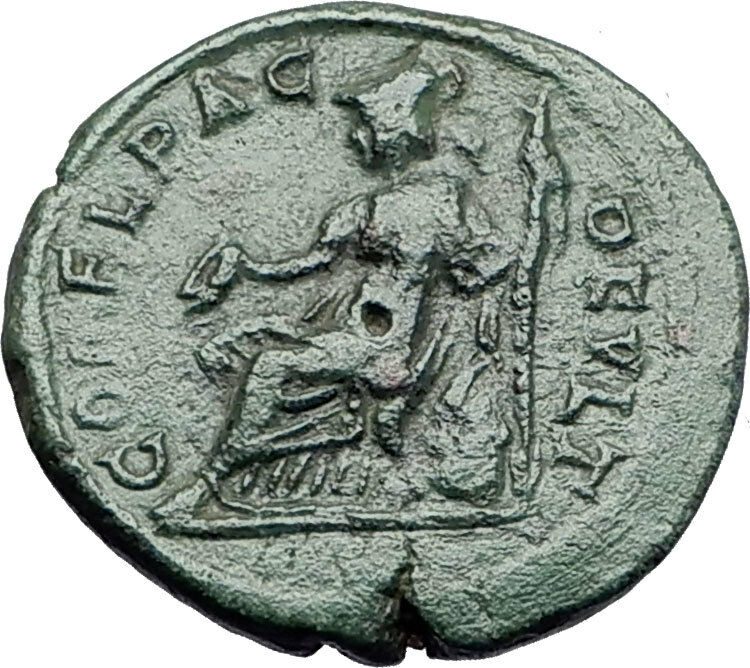|
Salonina – Roman Empress: 253-268 A.D. – Wife of Gallienus
Bronze 10 Assaria 29mm of Side in Pamphylia
Reference: SNG Paris -. SNG PFPS 872 var.
Certification: NGC Ancients Ch VF 4933660-013
KOPNHΛIA CAΛΩNINA CЄB / I, Diademed and draped bust of Salonina to right.
CIΔHTΩN•NЄΩKOPΩN Apollo Sidetes standing front, head to left, holding patera in his right hand and scepter with his left.
An important coastal city, south-east of Aspendos, Side was a place of great antiquity, resettled by colonists from Kyme in the 7th-6th century B.C. Its inhabitants, who abandoned Greek in favor of curious local dialect, were reputed to be most dishonest, and the city was a center for piracy in the 2nd and 1st centuries B.C.
You are bidding on the exact item pictured, provided with a Certificate of Authenticity and Lifetime Guarantee of Authenticity.
 In Greek and Roman mythology, Apollo, is one of the most important and diverse of the Olympian deities. The ideal of the kouros (a beardless youth), Apollo has been variously recognized as a god of light and the sun; truth and prophecy; archery; medicine and healing; music, poetry, and the arts; and more. Apollo is the son of Zeus and Leto, and has a twin sister, the chaste huntress Artemis. Apollo is known in Greek-influenced Etruscan mythology as Apulu. Apollo was worshiped in both ancient Greek and Roman religion, as well as in the modern Greco-Roman Neopaganism. In Greek and Roman mythology, Apollo, is one of the most important and diverse of the Olympian deities. The ideal of the kouros (a beardless youth), Apollo has been variously recognized as a god of light and the sun; truth and prophecy; archery; medicine and healing; music, poetry, and the arts; and more. Apollo is the son of Zeus and Leto, and has a twin sister, the chaste huntress Artemis. Apollo is known in Greek-influenced Etruscan mythology as Apulu. Apollo was worshiped in both ancient Greek and Roman religion, as well as in the modern Greco-Roman Neopaganism.
As the patron of Delphi (Pythian Apollo), Apollo was an oracular god – the prophetic deity of the Delphic Oracle. Medicine and healing were associated with Apollo, whether through the god himself or mediated through his son Asclepius, yet Apollo was also seen as a god who could bring ill-health and deadly plague as well as one who had the ability to cure. Amongst the god’s custodial charges, Apollo became associated with dominion over colonists, and as the patron defender of herds and flocks. As the leader of the Muses (Apollon Musagetes) and director of their choir, Apollo functioned as the patron god of music and poetry. Hermes created the lyre for him, and the instrument became a common attribute of Apollo. Hymns sung to Apollo were called paeans.
In Hellenistic times, especially during the third century BCE, as Apollo Helios he became identified among Greeks with Helios, god of the sun, and his sister Artemis similarly equated with Selene, goddess of the moon. In Latin texts, on the other hand, Joseph Fontenrose declared himself unable to find any conflation of Apollo with Sol among the Augustan poets of the first century, not even in the conjurations of Aeneas and Latinus in Aeneid XII (161-215). Apollo and Helios/Sol remained separate beings in literary and mythological texts until the third century CE.
 Side is an ancient Greek city on the southern Mediterranean coast of Turkey, a resort town and one of the best-known classical sites in the country. It lies near Manavgat and the village of Selimiye, 78 km from Antalya in the province of Antalya. Side is an ancient Greek city on the southern Mediterranean coast of Turkey, a resort town and one of the best-known classical sites in the country. It lies near Manavgat and the village of Selimiye, 78 km from Antalya in the province of Antalya.
It is located on the eastern part of the Pamphylian coast, which lies about 20 km east of the mouth of the Eurymedon River. Today, as in antiquity, the ancient city is situated on a small north-south peninsula about 1 km long and 400 m across.
 History History
Strabo and Arrian both record that Side was founded by Greek settlers from Cyme in Aeolis, a region of western Anatolia. This most likely occurred in the 7th century BC. Its tutelary deity was Athena, whose head adorned its coinage.
Dating from the tenth century B.C., its coinage bore the head of Athena (Minerva), the patroness of the city, with a legend. Its people, a piratical horde, quickly forgot their own language to adopt that of the aborigines.
Possessing a good harbour for small-craft boats, Side’s natural geography made it one of the most important places in Pamphylia and one of the most important trade centres in the region. According to Arrian, when settlers from Cyme came to Side, they could not understand the dialect. After a short while, the influence of this indigenous tongue was so great that the newcomers forgot their native Greek and started using the language of Side. Excavations have revealed several inscriptions written in this language. The inscriptions, dating from the 3rd and 2nd centuries BC, remain undeciphered, but testify that the local language was still in use several centuries after colonisation. Another object found in the excavations at Side, a basalt column base from the 7th century BC and attributable to the Neo-Hittites, provides further evidence of the site’s early history. The name Side may be Anatolian in origin, meaning pomegranate.
Next to no information exists concerning Side under Lydian and Persian sovereignty.
 Julia Cornelia Salonina (d. 268, Mediolanum) was an Augusta, wife of Roman Emperor Gallienus and mother of Valerian II, Saloninus, and Marinianus. Julia Cornelia Salonina (d. 268, Mediolanum) was an Augusta, wife of Roman Emperor Gallienus and mother of Valerian II, Saloninus, and Marinianus.
Julia Cornelia Salonina’s origin is unknown. According to a modern theory, she was born of Greek origin in Bithynia, then part of the province of Bithynia et Pontus, Asia Minor. However, there exists some scepticism on that. She was married to Gallienus about ten years before his accession to the throne. When her husband became joint-emperor with his father Valerian in 253, Cornelia Salonina was named Augusta.
Cornelia was the mother of three princes, Valerian II, Saloninus and Marinianus. Her fate, after the murder of Gallienus, during the siege of Mediolanum in 268, is unknown. It is likely that either her life was spared or the she was executed together with other members of her family, at the orders of the Senate of Rome.
Her name is reported on coins with Latin legend as Cornelia Salonina; however, from the Greek coinage come the names Iulia Cornelia Salonina, Publia Licinia Cornelia Salonina, and Salonina Chrysogona (attribute that means “begotten of gold”).
|









 In Greek and Roman mythology, Apollo, is one of the most important and diverse of the Olympian deities. The ideal of the kouros (a beardless youth), Apollo has been variously recognized as a god of light and the sun; truth and prophecy; archery; medicine and healing; music, poetry, and the arts; and more. Apollo is the son of Zeus and Leto, and has a twin sister, the chaste huntress Artemis. Apollo is known in Greek-influenced Etruscan mythology as Apulu. Apollo was worshiped in both ancient Greek and Roman religion, as well as in the modern Greco-Roman Neopaganism.
In Greek and Roman mythology, Apollo, is one of the most important and diverse of the Olympian deities. The ideal of the kouros (a beardless youth), Apollo has been variously recognized as a god of light and the sun; truth and prophecy; archery; medicine and healing; music, poetry, and the arts; and more. Apollo is the son of Zeus and Leto, and has a twin sister, the chaste huntress Artemis. Apollo is known in Greek-influenced Etruscan mythology as Apulu. Apollo was worshiped in both ancient Greek and Roman religion, as well as in the modern Greco-Roman Neopaganism. Side is an ancient Greek city on the southern Mediterranean coast of Turkey, a resort town and one of the best-known classical sites in the country. It lies near Manavgat and the village of Selimiye, 78 km from Antalya in the province of Antalya.
Side is an ancient Greek city on the southern Mediterranean coast of Turkey, a resort town and one of the best-known classical sites in the country. It lies near Manavgat and the village of Selimiye, 78 km from Antalya in the province of Antalya. History
History Julia Cornelia Salonina (d. 268, Mediolanum) was an Augusta, wife of Roman Emperor Gallienus and mother of Valerian II, Saloninus, and Marinianus.
Julia Cornelia Salonina (d. 268, Mediolanum) was an Augusta, wife of Roman Emperor Gallienus and mother of Valerian II, Saloninus, and Marinianus.




